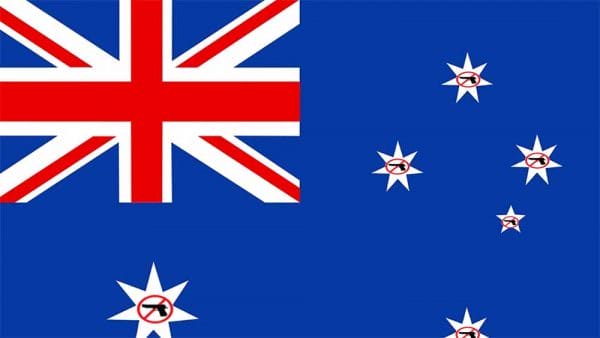Opinion by Alan J Chwick & Joanne D Eisen

USA – -(AmmoLand.com)- It’s obvious from the Democrats’ rhetoric that they do want our guns. They are uncomfortable with the thought of civilians and millions of conservative Americans owning firearms. And even though gun owners have compromised in past years on laws that have hardly functioned, the anti-gun crowd still believe that more restrictive laws will work to bring peace, as they keep promising.
Democrats believe that those laws didn’t work because they were not restrictive enough. And yet they continue to claim they are not asking for total disarmament.
The Democrats’ current idea of compromise is to permit only a few trusted people to own a single-shot firearm that would be infrequently used under highly controlled circumstances. And, none of those circumstances will include self-defense.
That was the path taken by Australia in 1996, soon after a shocking mass murder. At that time, Australians did a gun ‘buy back’, after which Australia did see decades of decline in firearms-enabled murder, suicide. The rate of private firearms ownership decreased, in addition to the elimination of firearm mass murder. But that all ended with the ‘Margaret River‘ murder-suicide in 2018. It is because of this narrow 22-year downturn in crime that American Democrats believe they can sell Australian-type disarmament to Americans.
Hillary Clinton wanted it. Democratic Representatives Jerry Nadler and Eric Swalwell want it. Former President Obama was, and still is, open to it. And many others are open to the idea.
And then we have the current White House ‘Resident’ Joe Biden, who wants whatever gun control he can get.
Biden would even love a ‘grandfather clause’ instead of an immediate buyback and disarmament, as that could be used to create a federal list of gun owners that would aid in the future disarmament attempt.
As usual, the devil is in the details, and without the details, the Australian story is misleading, and a lie. Oh, that’s right, American Democrats love to lie.
Here’s why the Australian path won’t work in America.
Here in America, in this time of sporadic partisan violence and demoralized police forces, our firearms might one day just save our lives. If banned, many Americans will keep them, and stay well under the radar, away from the justice system. People might believe the Democrats’ promise of a peaceful society, but Americans will prefer to keep their firearms handy. After all, it is what we are all about.
Even in Australia, fewer than 20% of Australians complied with the gun buybacks. This compares very well with the New York State SAFE ACT, which required registration of some military-style firearms. SAFE ACT compliance was less than 4% for mere registration, and not a buyback.
Still, the Australian government achieved what our Democrats crave. At this time in Australia, a few civilians still have some firearms which are great for plinking. But the criminals still have everything they could want in weapons. Was this cultural change worth it to Australia? Was making a huge portion of the AU population into criminals worth the cost just for 22 years without a firearm-related mass murder, a run that may have happened without the national buyback, aka confiscation,? And would it even be possible to achieve in America?
Our elected legislators should be concerned about the result of the Australian-style laws. Here, they need to understand that even their threats of universal background checks, designed to specifically create a government list of gun owners, are not going to work as promised because of huge citizen resistance.
Prof. Gary Mauser observes the cynicism and alienation of citizens that, “grows with the severity of the restrictions and with the ineffectiveness” of the result of these laws.
We, and our politicians, have only to look at the final lesson of Australia to see the outcome of futile government action. But first, it’s important to look at the situation in Australia before the 1996 gun ban, because the statistics observed before the ban literally stumped the scientists.
Between 1979 and 1996, and before the 1996 firearms buyback, Australia was experiencing a 47% drop in the rate of firearm homicides and a 40% drop in firearm suicides. Hence, there was no need for any ban, buyback, registration, or licensing of firearm owners.
If the Australian politicians were acting for the benefit of the population, they would not have changed firearms laws, because everything was working so well. It was obvious that the politicians were waiting for an excuse to gain control of gun owners and the estimated 3.9 to 6 million guns. They were ready to rapidly jump into action and spend taxpayer dollars when such an event would arise. Then, they got that event.
One Sunday afternoon in April 1996, there was a dramatic mass murder in Port Arthur, Tasmania, where 35 people were killed and 18 were wounded. However, the government narrative of that event has too many discrepancies to be fully accurate. The patsy, or if you prefer, the perpetrator, Martin Bryant, had an IQ of 66 which made him eligible for a government pension.
There were complex multiple crime scenes, a busy timeline of separate events, and a phone call to local police which diverted them away from the murders. Bryant could not possibly have thought out the details or accomplished all of the murders by himself. Who was the accomplice? Neither the prosecution nor Bryant’s lawyer had any concern with all the unanswered questions, even though Bryant had sufficient funds to pay for an investigation.
Bryant, and only Bryant, would be found guilty. Period. End of story.
With unusual speed, the Australian 1996 National Firearms Agreement (NFA) gave the country’s gun banners everything they ever wanted. Fully automatic and semiautomatic rifles and shotguns, plus pump-action shotguns were banned. All other firearms required registration and all owners required a license, leaving the government with a list of licensed owners.
By December 2003, after a second buyback, 713,000 firearms had been turned in. If one used the government guestimate of 3.9 million civilian-owned firearms, then 18.3% had been collected. But if one used the gun proponents’ higher guestimate of 6 million civilian guns, then that number drops to 11.8%. Either way, the country’s gun banners were very pleased.
But here is where the Australian NFA has unseen consequences – THE BLACK MARKET. The government should have known that most of the guns they considered so dangerous would merely be transferred to a black or gray market and that the government would lose control of them.
So What Happened In Australia?
Did Australia’s legal civilian gun culture change to a criminal gun culture?
By 2014, the black market was in full swing. The price of a semiautomatic handgun tripled to $15,000 (Aus).
And State Crime Command director Detective Chief Superintendent Ken Finch observed, “Obviously illegal importations are still happening; it’s just simply at the moment they aren’t being detected. We need to have an increased focus on border control.”
Right. That’s always the complaint when attempts to control those pesky markets fail. But there’s always a limit to the resources required to control a black market, and somehow, the market seems to deal with whatever that limit is. By 2017, the number of black market guns was estimated at being between 260,000 and 600,000, but we believe that estimate is quite low. What happened in 1996 to all those guns that were never turned in and never licensed?
Now, in 2021, noted firearms author Phillip Alpers acknowledged, “a significant shift in the country’s gun culture...each year a smaller segment of the population decide they need a firearm,” A firearm that is registered, that is.
A quarter of a century after the first buyback, there were 48% fewer Australians with gun licenses, because the license was so difficult to obtain and maintain. By 2021 there were only 3.4 licensed people per 100, instead of the 1996 figure of 6.5 per 100. And because licensed owners bought more guns, there are now 3.5 million post-ban registered firearms.
Was Australia’s NFA ban worth it? Yes, but only if the goal was to lower the percentage of licensed firearm owners, as it did accomplish that.
What Do The Australian Statistical Results Say?
A 2021 Rand Corp research review by Ramchand and Saunders gave some answers. Yes, firearm suicides and murders decreased after the buyback. But remember, they had also declined by almost 50% over the 15 years before the Australian buyback!
Was the reduction seen after the ban was implemented a continuation of the early downward trend, or was it because of the buyback?
The Ramchand and Saunders review found another complication that might help answer that question. They noted a post-ban reduction in non-firearm homicides and non-firearm suicides. The buyback was not designed to affect non-firearm homicides and non-firearm suicides. Did it? How was the decline in non-firearm homicides and non-firearm suicides related to the Australian NFA, or was it only a continuation of the earlier decline?
The Rand authors cited a Journal of the American Medical Association paper by Chapman, Alpers, and Jones. We shall also cite this paper because these are anti-gun authors who would try super hard to find causal effects, and yet they could not. And, kudos to them, they did not lie about it.
Chapman, et al, concluded;
“There was a more rapid decline in firearm deaths between 1997 and 2013 compared with before 1997 but also a decline in total non-firearm suicide and homicide deaths of a greater magnitude. Because of this, it is not possible to determine whether the change in firearm deaths can be attributed to the gun law reforms.”
That is, they could not find any reduction in violence from the Australian NFA.
The claim that the Australian NFA prevented mass murders is also misleading. America has developed a culture of mass murder due to the creation of gun-free zone laws. John Lott is very firm about the cure.
He said, “98% of mass public shootings since 1950 have occurred in places where citizens are banned from having guns…we need to get rid of gun-free zones.”
We are not Australia with a 1996 maximum civilian gun inventory of 6 million. America’s civilian gun inventory is currently estimated at over 400 million. Americans tend NOT TO BE COMPLIANT. Just remember the NYS SAFE ACT numbers.

One could easily believe, here in America, that the kind of involuntary buyback Australia instituted in 1996 would result in hundreds of millions of black market firearms, with mass criminalization of our citizens.
If we were to pass an Australian-style law, as Democrats want, we believe that America could never attain a safe society. That style of law would create chaos here. Instead of a disarmed peace, it would create mayhem.
As we started out on this piece, it’s obvious from the Democrats’ rhetoric that they do want our guns. Did you expect anything less? They always seem to make foolish policy decisions.
About The Authors
Alan J Chwick has been involved with firearms much of his life and is the Retired Managing Coach of the Freeport NY Junior Marksmanship Club. He has escaped from New York State to South Carolina and is an SC FFL (Everything22andMore.com). AJChwick@iNCNF.org | TWITTER: @iNCNF
Joanne D Eisen, DDS (Ret.) practiced dentistry on Long Island, NY. She has collaborated and written on firearm politics for the past 30+ years. She has also escaped New York State, but to Virginia. JoanneDEisen@cs.com
The post Biden Democrats: Want The Failed Australian Gun Ban Plan appeared first on AmmoLand.com.
from https://ift.tt/2U0Uv9R
via IFTTT

No comments:
Post a Comment